Long-Term Immune Response to SARS-CoV-2 Vaccination in Hematologic Malignancies: An Update of the ImV-HOng Trial of the East German Study Group for Hematology and Oncology
Simple Summary
Abstract
1. Introduction
2. Materials and Methods
2.1. Study Design
2.2. Study Cohorts
2.3. Outcomes
2.4. Procedures
2.5. Laboratory Measurements
2.5.1. Measurement of SARS-CoV-2 Spike Protein Antibodies
2.5.2. SARS-CoV-2 Spike-Specific T-Cell Response
2.6. Statistical Analysis
3. Results
3.1. Patient Characteristics
3.2. SARS-CoV-2 Spike-Specific Humoral Response
3.3. SARS-CoV-2 Spike-Specific T-Cell Response
4. Discussion
5. Conclusions
Author Contributions
Funding
Institutional Review Board Statement
Informed Consent Statement
Data Availability Statement
Acknowledgments
Conflicts of Interest
References
- Sakuraba, A.; Luna, A.; Micic, D. Serologic response following SARS-COV2 vaccination in patients with cancer: A systematic review and meta-analysis. J. Hematol. Oncol. 2022, 15, 15. [Google Scholar] [CrossRef] [PubMed]
- Hillyer, A.; Quint, A.; Ghassemian, A.; Joh-Carnella, N.; Knauer, M.J.; Dawd, D.; Lazo-Langner, A.; Mangel, J.; Lam, S.; Abdoh, H.; et al. Serologic Response to Vaccine for COVID-19 in Patients with Hematologic Malignancy: A Prospective Cohort Study. Clin. Lymphoma Myeloma Leuk. 2024, 24, 305–315. [Google Scholar] [CrossRef] [PubMed]
- Centers for Disease Control and Prevention: Vaccines & Immunizations. Use of COVID-19 Vaccines in the United States. Interim Clinical Considerations. Available online: https://www.cdc.gov/vaccines/covid-19/clinical-considerations/covid-19-vaccines-us.html (accessed on 22 February 2025).
- Jotschke, S.; Schulze, S.; Jaekel, N.; Ludwig-Kraus, B.; Engelmann, R.; Kraus, F.B.; Zahn, C.; Nedlitz, N.; Prange-Krex, G.; Mohm, J.; et al. Longitudinal Humoral and Cellular Immune Responses Following SARS-CoV-2 Vaccination in Patients with Myeloid and Lymphoid Neoplasms Compared to a Reference Cohort: Results of a Prospective Trial of the East German Study Group for Hematology and Oncology (OSHO). Cancers 2022, 14, 1544. [Google Scholar] [CrossRef]
- Engelmann, R.; Jaekel, N.; Jotschke, S.; Ludwig-Kraus, B.; Kraus, F.B.; Kumari, N.; Schulze, S.; Hecker, M.; Zahn, C.; Al-Ali, H.K.; et al. Vector-based SARS-CoV-2 vaccination is associated with improved T-cell responses in hematological neoplasia. Blood Adv. 2023, 7, 3403–3415. [Google Scholar] [CrossRef] [PubMed]
- Apostolidis, S.A.; Kakara, M.; Painter, M.M.; Goel, R.R.; Mathew, D.; Lenzi, K.; Rezk, A.; Patterson, K.R.; Espinoza, D.A.; Kadri, J.C.; et al. Cellular and humoral immune responses following SARS-CoV-2 mRNA vaccination in patients with multiple sclerosis on anti-CD20 therapy. Nat. Med. 2021, 27, 1990–2001. [Google Scholar] [CrossRef] [PubMed]
- Kamboj, M.; Bohlke, K.; Baptiste, D.M.; Dunleavy, K.; Fueger, A.; Jones, L.; Kelkar, A.H.; Law, L.Y.; LeFebvre, K.B.; Ljungman, P.; et al. Vaccination of Adults with Cancer: ASCO Guideline. J. Clin. Oncol. 2024, 42, 1699–1721. [Google Scholar] [CrossRef] [PubMed]
- Riester, E.; Findeisen, P.; Hegel, J.K.; Kabesch, M.; Ambrosch, A.; Rank, C.M.; Pessl, F.; Laengin, T.; Niederhauser, C. Performance evaluation of the Roche Elecsys Anti-SARS-CoV-2 S immunoassay. J. Virol. Methods 2021, 297, 114271. [Google Scholar] [CrossRef] [PubMed]
- Knezevic, I.; Mattiuzzo, G.; Page, M.; Minor, P.; Griffiths, E.; Nuebling, M.; Moorthy, V. WHO International Standard for evaluation of the antibody response to COVID-19 vaccines: Call for urgent action by the scientific community. Lancet Microbe 2022, 3, e235–e240. [Google Scholar] [CrossRef] [PubMed]
- WHO International Institute for Biological Standards and Control. First WHO International Standard Anti-SARS-CoV-2 Immunoglobulin (Human). Version 2.0. NIBSC Code: 20/136. Counter = 1213. Available online: https://www.nibsc.org/products/brm_product_catalogue/detail_page.aspx?catid=20/136 (accessed on 1 June 2025).
- Kalina, T.; Flores-Montero, J.; van der Velden, V.H.J.; Martin-Ayuso, M.; Böttcher, S.; Ritgen, M.; Almeida, J.; Lhermitte, L.; Asnafi, V.; Mendonça, A.; et al. EuroFlow standardization of flow cytometer instrument settings and immunophenotyping protocols. Leukemia 2012, 26, 1986–2010. [Google Scholar] [CrossRef] [PubMed]
- McNeil, L.K.; Price, L.; Britten, C.M.; Jaimes, M.; Maecker, H.; Odunsi, K.; Matsuzaki, J.; Staats, J.S.; Thorpe, J.; Yuan, J.; et al. A harmonized approach to intracellular cytokine staining gating: Results from an international multiconsortia proficiency panel conducted by the Cancer Immunotherapy Consortium (CIC/CRI). Cytom. A 2013, 83, 728–738. [Google Scholar] [CrossRef] [PubMed]
- Price, L.S.; Adamow, M.; Attig, S.; Fecci, P.; Norberg, P.; Reap, E.; Janetzki, S.; McNeil, L.K. Gating Harmonization Guidelines for Intracellular Cytokine Staining Validated in Second International Multiconsortia Proficiency Panel Conducted by Cancer Immunotherapy Consortium (CIC/CRI). Cytom. A 2021, 99, 107–116. [Google Scholar] [CrossRef] [PubMed]
- Sahin, U.; Muik, A.; Vogler, I.; Derhovanessian, E.; Kranz, L.M.; Vormehr, M.; Quandt, J.; Bidmon, N.; Ulges, A.; Baum, A.; et al. BNT162b2 vaccine induces neutralizing antibodies and poly-specific T cells in humans. Nature 2021, 595, 572–577. [Google Scholar] [CrossRef] [PubMed]
- Schmidt, T.; Klemis, V.; Schub, D.; Mihm, J.; Hielscher, F.; Marx, S.; Abu-Omar, A.; Ziegler, L.; Guckelmus, C.; Urschel, R.; et al. Immunogenicity and reactogenicity of heterologous ChAdOx1 nCoV-19/mRNA vaccination. Nat. Med. 2021, 27, 1530–1535. [Google Scholar] [CrossRef] [PubMed]
- Karmacharya, A.; Rai, K.; Siwakoti, S.; Khanal, B.; Bhattarai, N.R. COVID-19 breakthrough infections in vaccinated individuals at BPKIHS, Nepal. BMC Infect. Dis. 2024, 24, 1003. [Google Scholar] [CrossRef] [PubMed]
- Bruce, M.G.; Bruden, D.; Hurlburt, D.; Zanis, C.; Thompson, G.; Rea, L.; Toomey, M.; Townshend-Bulson, L.; Rudolph, K.; Bulkow, L.; et al. Antibody Levels and Protection After Hepatitis B Vaccine: Results of a 30-Year Follow-up Study and Response to a Booster Dose. J. Infect. Dis. 2016, 214, 16–22. [Google Scholar] [CrossRef] [PubMed]
- Skelly, D.T.; Harding, A.C.; Gilbert-Jaramillo, J.; Knight, M.L.; Longet, S.; Brown, A.; Adele, S.; Adland, E.; Brown, H.; Medawar Laboratory Team; et al. Two doses of SARS-CoV-2 vaccination induce robust immune responses to emerging SARS-CoV-2 variants of concern. Nat. Commun. 2021, 12, 5061. [Google Scholar] [CrossRef] [PubMed]
- Wolschke, C.; Stübig, T.; Hegenbart, U.; Schönland, S.; Heinzelmann, M.; Hildebrandt, Y.; Ayuk, F.; Atanackovic, D.; Dreger, P.; Zander, A.; et al. Postallograft lenalidomide induces strong NK cell-mediated antimyeloma activity and risk for T cell-mediated GvHD: Results from a phase I/II dose-finding study. Exp. Hematol. 2013, 41, 134–142.e3. [Google Scholar] [CrossRef] [PubMed]

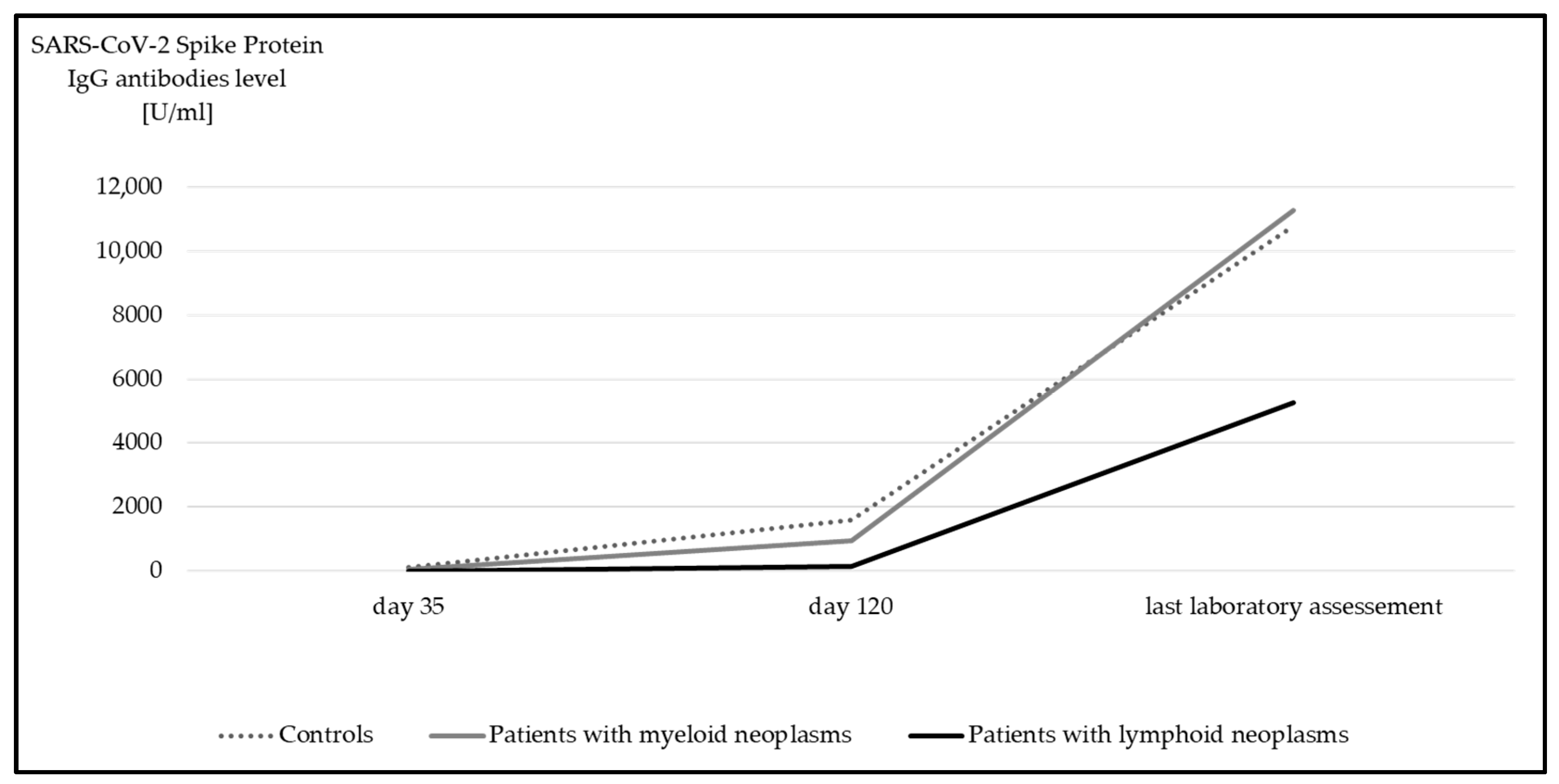

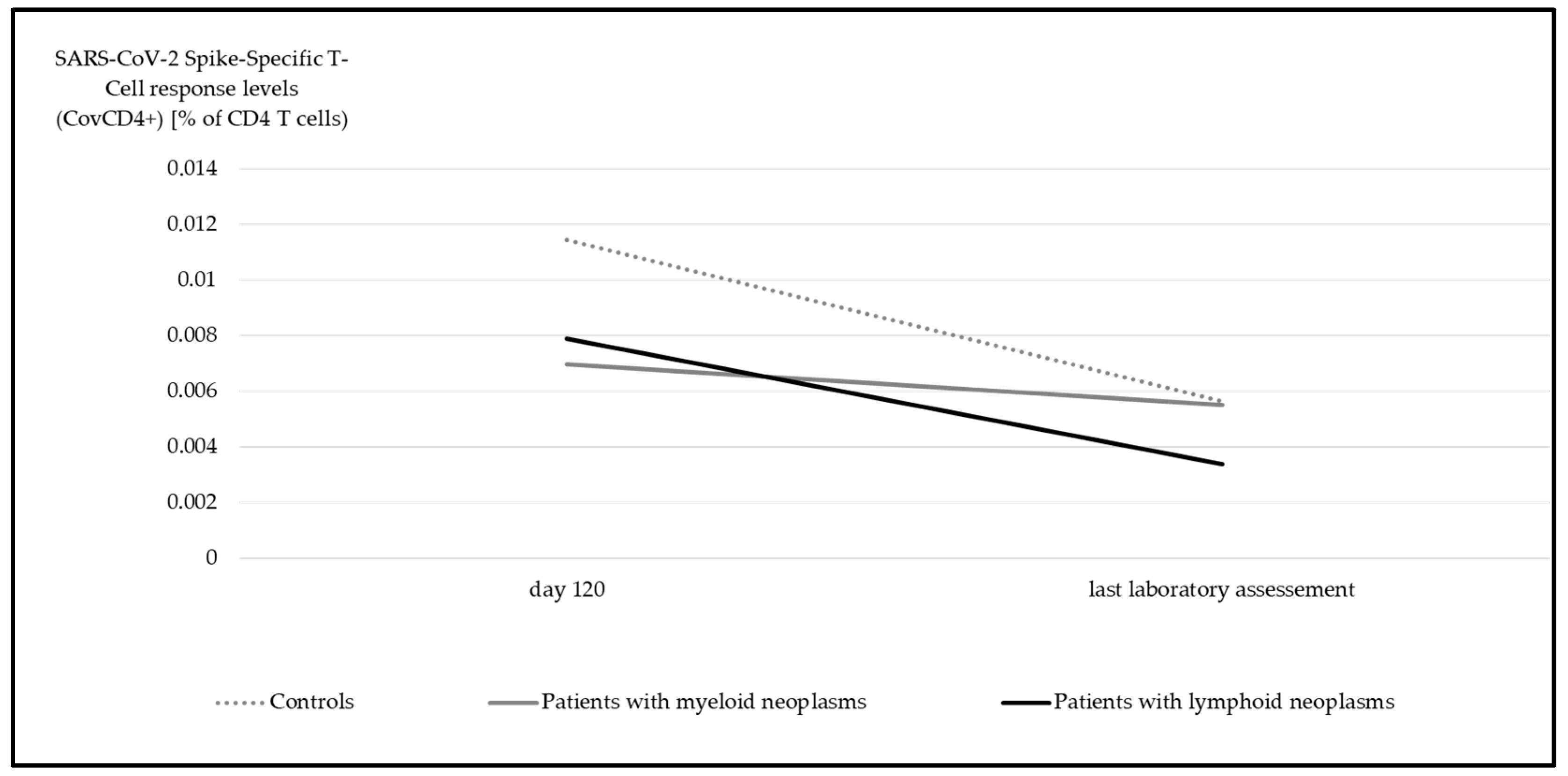
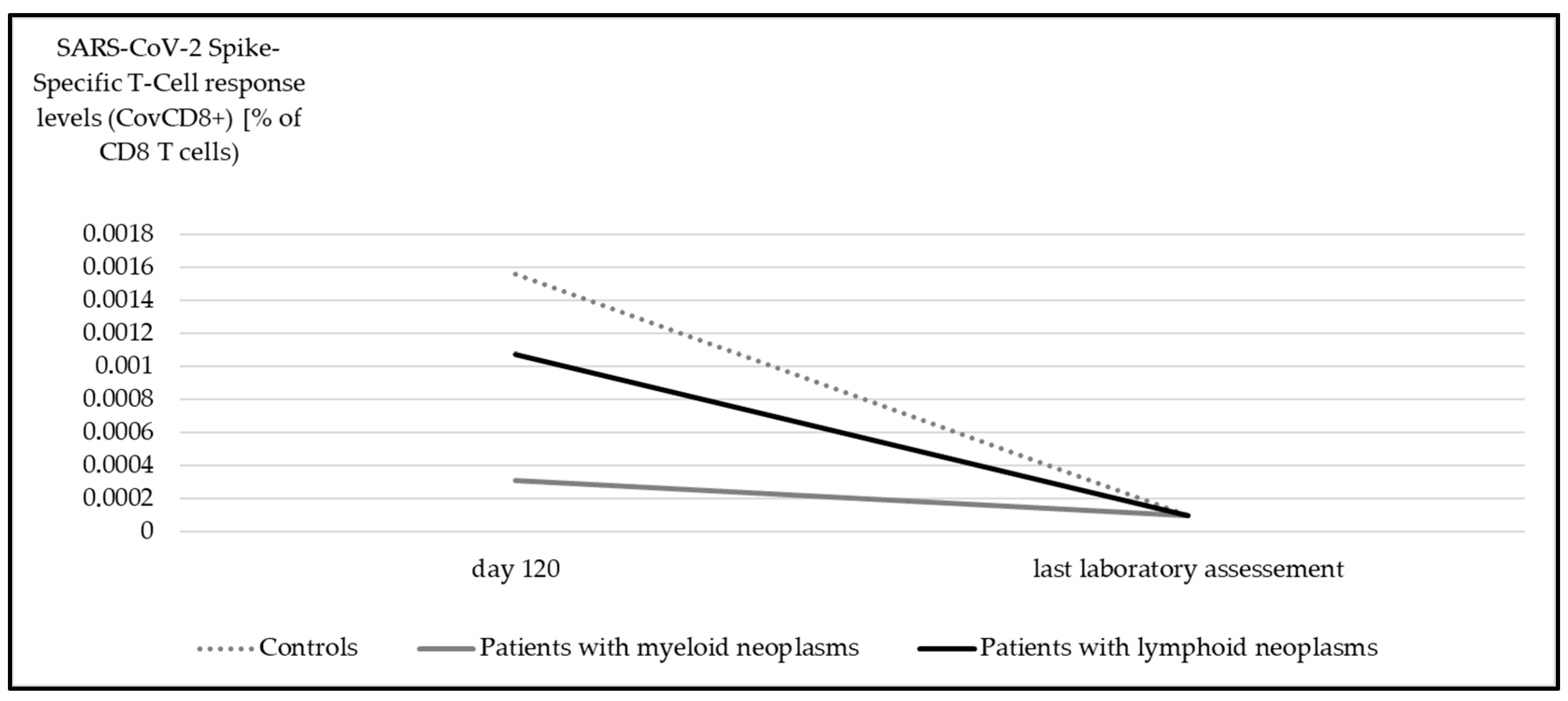
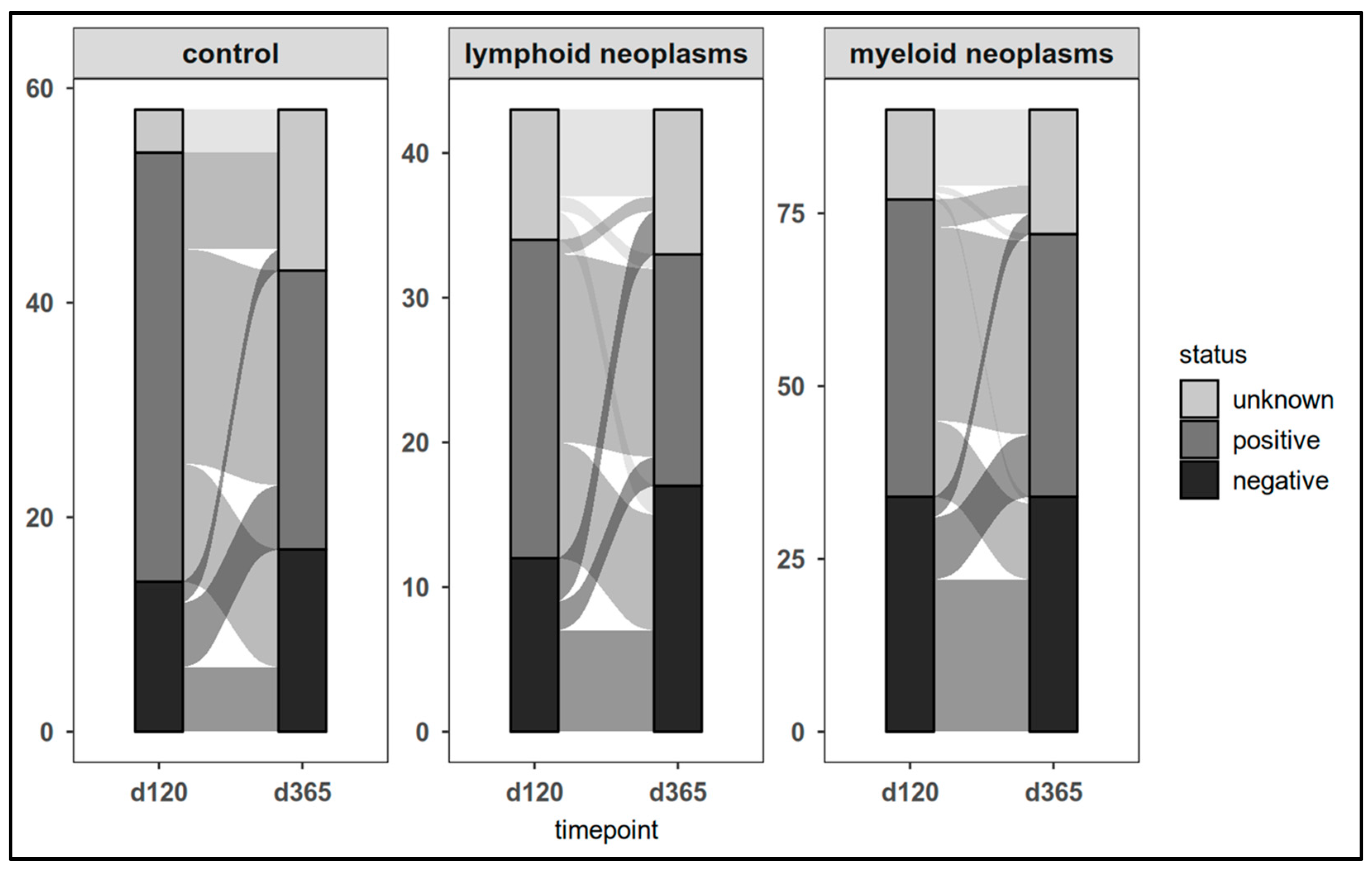
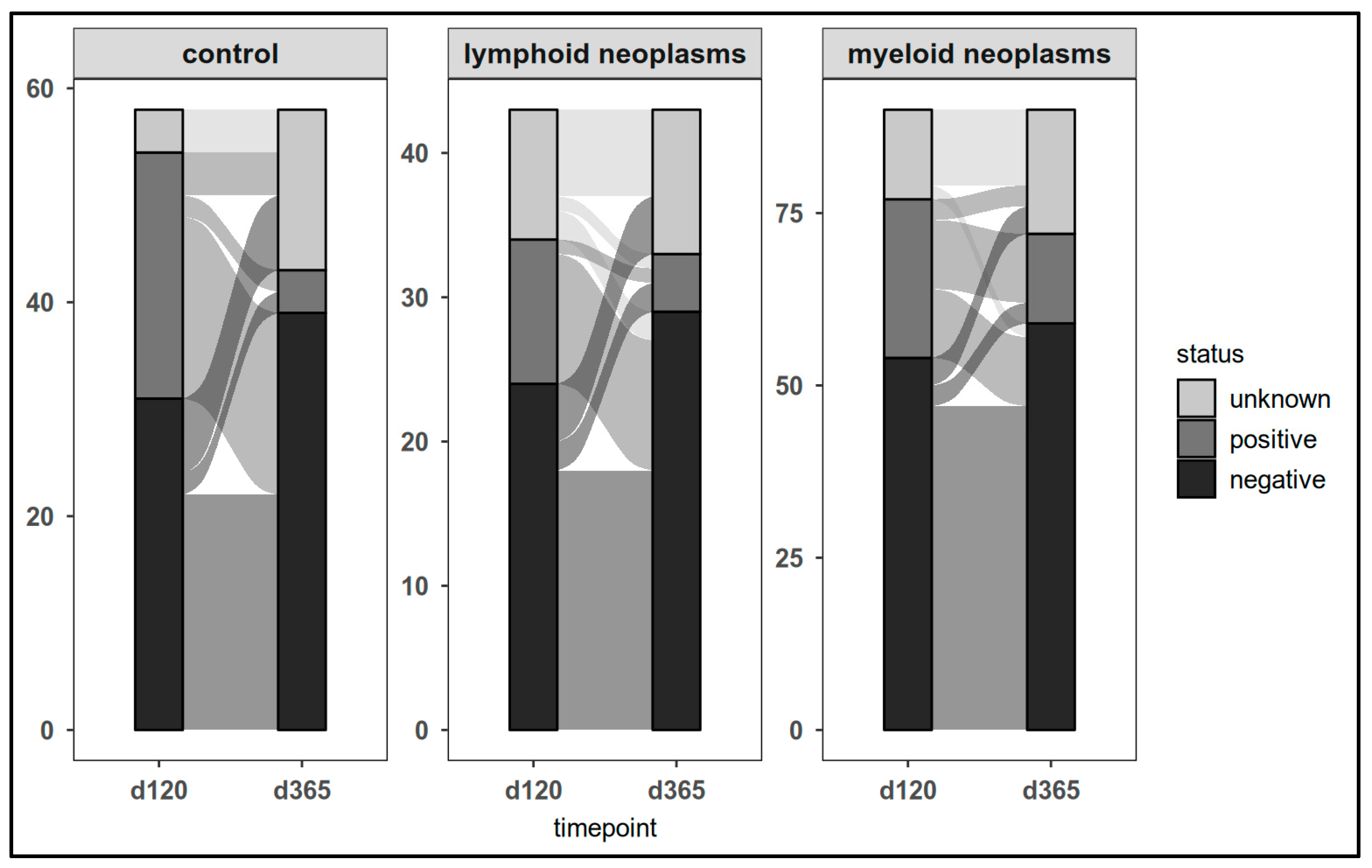
| Controls | Patients | |
|---|---|---|
| Inclusion criteria | Participation in the original ImV-HOng-Study | Participation in the original ImV-HOng-Study |
| Willing to participate in the Amendment 1 of the ImV-HOng-study | Willing to participate in the Amendment 1 of the ImV-HOng-study | |
| Age ≥ 18 years | Age ≥ 18 years | |
| No active malignancy in the last 5 years | Presence of one of the following diagnoses: - myeloid neoplasm - lymphoid neoplasm | |
| Exclusion criteria | Limited legal capacity to consent | Limited legal capacity to consent |
| Parameter at Last Assessement | Total Cohort n = 191 | Controls n = 58 | Patients n = 133 | p Value (Controls vs. Patients) | Patients with Myeloid Neoplasms n = 90 | Patients with Lymphoid Neoplasms n = 43 | p Value (Myeloid vs. Lymphoid) | p Value (Controls vs. Myeloid) | p Value (Controls vs. Lymphoid) | |
|---|---|---|---|---|---|---|---|---|---|---|
| Timepoint of last assessment from first vaccination (month) | median (IQR) | 18.4 (17.2–19.5) | 18.6 (17.4–19.7) | 18.3 (17.2–19.3) | 0.2 ** | 18.1 (17.0–19.2) | 18.4 (17.3–19.6) | 0.2 ** | 0.08 ** | 0.8 ** |
| Age (y) | median (IQR) | 57 (46–67) | 51 (34–60) | 60 (50–69) | < 0.001 ** | 59 (50–66) | 68 (49–77) | 0.04 ** | 0.003 ** | < 0.001 ** |
| Age ≥ 60 years | n (%) | 85 (44.5) | 16 (27.6) | 69 (51.9) | 0.002 * | 43 (47.8) | 26 (60.5) | 0.2 * | 0.01 * | < 0.001 * |
| Gender, male | 99 (51.8) | 22 (37.9) | 77 (57.9) | 0.01 * | 52 (57.8) | 25 (58.1) | 0.97 * | 0.02 * | 0.04 * | |
| Diagnoses | ||||||||||
| MPN | n (%) | 61 (31.9) | NA | 61 (45.9) | NA | 61 (67.8) | NA | NA | NA | NA |
| AML | 9 (4.7) | NA | 9 (6.8) | NA | 9 (10) | NA | NA | NA | NA | |
| MDS | 12 (6.3) | NA | 12 (9.0) | NA | 12 (13.3) | NA | NA | NA | NA | |
| Lymphoma | 13 (6.8) | NA | 13 (9.8) | NA | NA | 13 (30.3) | NA | NA | NA | |
| CLL | 10 (5.2) | NA | 10 (7.5) | NA | NA | 10 (23.3) | NA | NA | NA | |
| Multiple myeloma | 10 (5.2) | NA | 10 (7.5) | NA | NA | 10 (23.3) | NA | NA | NA | |
| Others # | 18 (9.4) | NA | 18 (13.5) | NA | 8 (8.9) | 10 (23.3) | NA | NA | NA | |
| Oncological therapy ### | n (%) | 91 (47.6) | NA | 91 (68.4) | NA | 68 (75.6) | 23 (53.5) | 0.1 * | NA | NA |
| TKI | 40 (44.0) | NA | 40 (44.0) | NA | 37 (54.4) | 3 (13.4) | NA | NA | NA | |
| Interferone | 8 (8.8) | NA | 8 (8.8) | NA | 8 (11.8) | 0 (0) | NA | NA | NA | |
| BTK-inhibitor | 6 (6.6) | NA | 6 (6.6) | NA | 1 (1.5) | 5 (21.7) | NA | NA | NA | |
| B-cell-depleting therapy | 5 (5.5) | NA | 5 (5.5) | NA | 0 (0) | 5 (21.7) | NA | NA | NA | |
| Chemotherapy | 16 (17.6) | NA | 16 (17.6) | NA | 11 (14.7) | 4 (17.4) | NA | NA | NA | |
| Immunomodulators | 6 (6.6) | NA | 6 (6.6) | NA | 0 (0) | 6 (26.1) | NA | NA | NA | |
| Small molecules | 8 (8.8) | NA | 8 (8.8) | NA | 6 (8.8) | 2 (8.7) | NA | NA | NA | |
| Immunosuppressive therapy | 7 (7.7) | NA | 7 (7.7) | NA | 6 (8.8) | 1 (4.3) | NA | NA | NA | |
| Others ## | 11 (12.1) | NA | 11 (12.1) | NA | 8 (11.8) | 3 (13.4) | NA | NA | NA | |
| Allogeneic HCT < 5 years prior to vaccination | n (%) | 13 (6.8) | NA | 13 (9.8) | NA | 10 (11.1) | 3 (7.0) | NA | NA | NA |
| Number of vaccinations | ||||||||||
| 1 | n (%) | 10 (5.2) | 5 (8.6) | 5 (3.8) | 0.4 ** | 5 (5.6) | 0 (0) | 0.03 ** | 0.9 ** | 0.1 ** |
| 2 | 32 (16.8) | 12 (20.7) | 20 (15.0) | 15 (16.7) | 5 (11.6) | |||||
| 3 | 116 (60.7) | 30 (51.7) | 86 (64.7) | 59 (65.6) | 27 (62.8) | |||||
| ≥4 | 33 (17.3) | 11 (18.9) | 22 (16.5) | 11 (12.2) | 11 (25.6) | |||||
| Type of vaccine | ||||||||||
| mRNA-based | n (%) | 149 (78) | 37 (63.8) | 112 (84.2) | 0.002 * | 74 (82.2) | 38 (88.4) | 0.6 * | 0.02 * | 0.01 * |
| Vector-based | 8 (4.2) | 6 (10.3) | 2 (1.5) | 2 (2.2) | 0 (0) | |||||
| mRNA+vector-based | 34 (17.8) | 15 (25.9) | 19 (14.3) | 14 (15.6) | 5 (11.6) | |||||
| SARS-CoV-2 infections | ||||||||||
| Infection prior to first vaccination | n (%) | 8 (4.2) | 1 (1.7) | 7 (5.3) | 0.4 * | 5 (5.6) | 2 (4.7) | 1.0 * | 0.4 * | 0.6 * |
| Infection after vaccination | 100 (52.4) | 39 (67.2) | 61 (45.9) | 0.007 * | 40 (44.4) | 21 (48.8) | 0.6 * | 0.007 * | 0.1 * |
| Parameter at Last Assessement | Total Cohort n = 191 | Controls n = 58 | Patients n = 133 | p Value (Controls vs. Patients) | Patients with Myeloid Neoplasms n = 90 | Patients with Lymphoid Neoplasms n = 43 | p Value (Myeloid vs. Lymphoid) | p Value (Controls vs. Myeloid) | p Value (Controls vs. Lymphoid) | |
|---|---|---|---|---|---|---|---|---|---|---|
| Timepoint of last assessment from first vaccination (month) | median (IQR) | 18.4 (17.2–19.5) | 18.6 (17.4–19.7) | 18.3 (17.2–19.3) | 0.2 ** | 18.1 (17.0–19.2) | 18.4 (17.3–19.6) | 0.2 ** | 0.08 ** | 0.8 ** |
| Intervals to last assessment | ||||||||||
| Interval from last vaccination (months) | media (IQR) | 10.8 (8.9–12.3) | 10.9 (9.3–12.9) | 10.8 (8.7–12.0) | 0.3 ** | 11.0 (9.2–12.4) | 10.0 (6.7–11.0) | 0.1 ** | 0.03 ** | 0.8 ** |
| Interval from last infection after vaccination (months) (n = 100/191) | 6.9 (3.1–9.1) | 7.8 (4.9–9.6) | 6.5 (2.2–8.9) | 0.2 ** | 5.6 (2.2–8.6) | 7.5 (2.2–9.4) | 0.7 ** | 0.5 ** | 0.2 ** | |
| Interval from last event (infection or vaccination) (months) | 8.4 (4.6–10.5) | 7.8 (4.5–9.9) | 8.7 (4.5–10.8) | 0.4 ** | 9.0 (5.2–11.0) | 8.2 (2.4–10.4) | 0.1 ** | 0.8 ** | 0.2 ** | |
| SARS–CoV–2 Spike Protein IgG antibodies levels | ||||||||||
| Day 35 | median (IQR) [U/ml] | 34.7 (2.1–362.5) | 125.0 (24.9–587.0) | 12.8 (0.5–299.0) | <0.001 ** | 34.7 (2.8–594.5) | 0.6 (0.4–57.3) | <0.001 ** | 0.1 ** | <0.001 ** |
| Day 120 | 856.0 (140.5–2381.5) | 1590.5 (407.8–3253.8) | 564.0 (71.6–2092.0) | 0.004 ** | 941.5 (150.5–3324.5) | 155.0 (1.4–574.5) | <0.001 ** | 0.2 ** | <0.001 ** | |
| Last assessment | 10600.0 (3359.0–20649.0) | 10797.0 (5441.3–19903.5) | 10396.0 (1921.5–22076.5) | 0.02 ** | 11266.5 (3902.3–22327.5) | 5274.0 (702.0–19278.0) | 0.05 ** | 0.95 ** | 0.04 ** | |
| SARS–CoV–2 Spike–Specific T–Cell response levels (n = 148/191) | ||||||||||
| CovCD4+ day 120 last assessment | median (IQR) [% of CD4+ T cells] | 0.00902 (0.002485–0.020905) | 0.01144 (0.004445–0.019825) | 0.00697 (0.00228–0.02241) | 0.4 ** | 0.00697 (0.00153–0.01966) | 0.00788 (0.0028075–0.0279525) | 0.3 ** | 0.2 ** | 0.9 ** |
| 0.00541 (0.0014725–0.0126725) | 0.00563 (0.00231–0.01220) | 0.00516 (0.00109–0.012775) | 0.5 ** | 0.005505 (0.001165–0.01242) | 0.00336 (0.00066–0.01462) | 0.6 ** | 0.7 ** | 0.4 ** | ||
| CovCD8+ day 120 last assessment | ||||||||||
| median (IQR) [% of CD8+ T cells] | 0.00102 (0.0001–0.004665) | 0.00156 (0.000525–0.0057425) | 0.00078 (0.0001–0.00396) | 0.03 ** | 0.00031 (0.0001–0.00415) | 0.0010750 (0.0001–0.0039775) | 0.4 ** | 0.02 ** | 0.3 ** | |
| 0.0001 (0.0001–0.00099) | 0.0001 (0.0001–0.00066) | 0.0001 (0.0001–0.00133) | 0.6 ** | 0.0001 (0.0001–0.001265) | 0.0001 (0.0001–0.001615) | 0.8 ** | 0.8 ** | 0.6 ** |
Disclaimer/Publisher’s Note: The statements, opinions and data contained in all publications are solely those of the individual author(s) and contributor(s) and not of MDPI and/or the editor(s). MDPI and/or the editor(s) disclaim responsibility for any injury to people or property resulting from any ideas, methods, instructions or products referred to in the content. |
© 2025 by the authors. Licensee MDPI, Basel, Switzerland. This article is an open access article distributed under the terms and conditions of the Creative Commons Attribution (CC BY) license (https://creativecommons.org/licenses/by/4.0/).
Share and Cite
Schulze, S.; Jotschke, S.; Engelmann, R.; Ludwig-Kraus, B.; Kraus, F.B.; Jaekel, N.; Zahn, C.; Junghanss, C.; Böttcher, S.; Al-Ali, H.K. Long-Term Immune Response to SARS-CoV-2 Vaccination in Hematologic Malignancies: An Update of the ImV-HOng Trial of the East German Study Group for Hematology and Oncology. Cancers 2025, 17, 2674. https://doi.org/10.3390/cancers17162674
Schulze S, Jotschke S, Engelmann R, Ludwig-Kraus B, Kraus FB, Jaekel N, Zahn C, Junghanss C, Böttcher S, Al-Ali HK. Long-Term Immune Response to SARS-CoV-2 Vaccination in Hematologic Malignancies: An Update of the ImV-HOng Trial of the East German Study Group for Hematology and Oncology. Cancers. 2025; 17(16):2674. https://doi.org/10.3390/cancers17162674
Chicago/Turabian StyleSchulze, Susann, Sabrina Jotschke, Robby Engelmann, Beatrice Ludwig-Kraus, Frank Bernhard Kraus, Nadja Jaekel, Christina Zahn, Christian Junghanss, Sebastian Böttcher, and Haifa Kathrin Al-Ali. 2025. "Long-Term Immune Response to SARS-CoV-2 Vaccination in Hematologic Malignancies: An Update of the ImV-HOng Trial of the East German Study Group for Hematology and Oncology" Cancers 17, no. 16: 2674. https://doi.org/10.3390/cancers17162674
APA StyleSchulze, S., Jotschke, S., Engelmann, R., Ludwig-Kraus, B., Kraus, F. B., Jaekel, N., Zahn, C., Junghanss, C., Böttcher, S., & Al-Ali, H. K. (2025). Long-Term Immune Response to SARS-CoV-2 Vaccination in Hematologic Malignancies: An Update of the ImV-HOng Trial of the East German Study Group for Hematology and Oncology. Cancers, 17(16), 2674. https://doi.org/10.3390/cancers17162674







